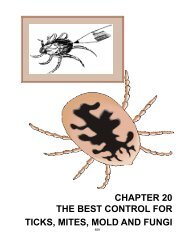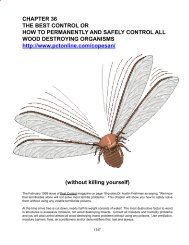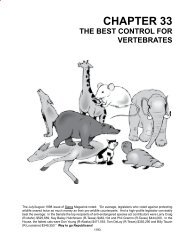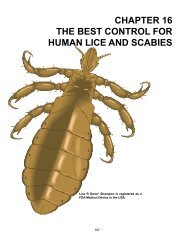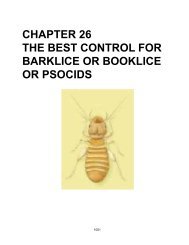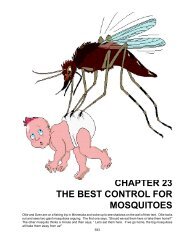then estimated human population. Gilbert Waldauer, Ph.D. noted humans have now doubled in number, so thatthe insects only outweigh us by a factor of 6. If the human population continues to grow, Gilbert, author of “<strong>The</strong>Handy Bug Answer Book” notes, there will come a time when there are not enough insects to support us. <strong>The</strong>insects pollinate our crops, aerate our soil, eliminate our wastes and help sustain the fabric of life.Designated Eating Areas - If you expect to contain, limit and/or control pest problems, it is vital todesignate appropriate areas for eating and enforce your rules about eating only in these areas.An editorial in the first number of <strong>The</strong> Practical Entomologist, 1865 stated: “<strong>The</strong> proposed decoctionsand washes we are well satisfied, in the majority of instances, are as useless in application as they areridiculous in composition, and if the work of destroying insects is to be accomplished satisfactorily, wefeel confident that it will have to be the result of no chemical preparations, but of simple means, directedby a knowledge of the history and habits of the depredators.”“We shall require a substantially new manner of thinking, if mankind is to survive.” — Albert Einstein“<strong>The</strong> important thing is not to stop questioning. Curiosity has its own reason for existing. One can nothelp but be in awe when he contemplates the mysteries of eternity of life, of the marvelous structure ofreality. It is enough if one tries merely to comprehend a little of this mystery every day. Never lose aholy curiosity.” — Albert Einstein“We should no longer accept the counsel of those who tell us that we must fill our world with poisonouschemicals; we should look about and see what other course is open to us.” — Rachel Carson, SilentSpring, 1962.“All men dream, but not equally. Those who dream by night in the dusty recessesof their minds wake in the day to find that it was vanity; but the dreamers of theday are dangerous men, for they may act their dreams with open eyes to make itpossible.” — T. E. Lawrence“If any man can convince me and bring home to me that I do not think or act aright, gladly will I change:for I search after truth by which man never yet was harmed. But he is harmed who abides on still in hisdeception and ignorance.” — Marcus Aurelius AntoniusRobert Mesecher from the Michigan DOA always said “If it is not expressly forbidden on the (poison)label, you may use it.” By this one statement, all of “the Author’s” pestisafes are legal.What’s Next? At the time of this writing we were looking at using hydrogen peroxide for insect, fungusand mildew control. <strong>The</strong> Author hasve successfully used Noxema to repel mosquitoes. You can use480
acetaminophen baits to kill snakes, but use caution as it will also kill cats. You can use sound waves oracoustic energy to kill mosquito larvae in the water. We are spraying fruit with nine packages of grapeKool-Aid per gallon of water to stop birds from eating the fruit. A clay called Kaolin can be sprayed onplants to repel insects. Ozone can be used to kill/repel insect pests. Algae bacteria and enzyme solutionscan be created on location to clean, disinfect, improve soil and control pest problems. Colloidalsolutions will be researched in depth. Colloidal silver, copper, etc. should work systemically in plantsand/or to control various wood destroying insects and organisms. Colloidal silver may stop and/orprevent “black goo”. Ions in water, oil, air, etc. should be effective pestisafes. “Medical grade” ozonemay also be useful in pest control and may be in the air, water, oils, etc. Biological controls will, obviously,be important pestisafes. Probiotic microbes and enzyme/surfactant combinations will continueto be refined, combined and/or improved. We are working on a cleaner/degreaser that will safely controlvegetation. We are also working with cedar oil as an insect barrier. We are working with various ultrasonic“critter” repellers. We have also been testing and/or using other common tinctures or oils that areGRAS materials, e.g., thyme oil, clove oil, cinnamon oil, peppermint oil, orange oil, lavender oil, citrusoil, lemongrass oil, eucalyptus oil, anise oil, pennyroyal oil, etc. Many are insecticidal, especially witha surfactant they can also repel pests, can be effective as fungicides, miticides, nematocides; some aregreat synergists; others act as anti-feedants. Canola oil comes from the rape seed which is part of themustard family. Rape is the most toxic of all food-oil plants. Like soy, rape is a weed that most insectswill not eat. <strong>The</strong> oil from rape seed is a hundred times more toxic than soy oil. Rape oil was the source ofthe chemical warfare agent called mustard gas. Canola oil contains large amounts of “isothiocyanates” -cyanide-containing compounds. Rotenone comes from soy beans. Canola oil is also high in glycosidesthat block enzyme function. <strong>The</strong> presence of glycosides in rattlesnake venom inhibits muscle enzymesand causes instant immobilization of the prey. Several essential oils block octopamine binding in aninsect’s nerves, thus creating death; humans and pets do not have octopamine receptors. We have alsofound that aspartame and MSG can be used to kill insects because they are “excitotoxins” that destroyneurons by over excitation when they are present in too high of a concentration in living organisms, soa “safe” dose in your food or drink will easily kill most insects. <strong>The</strong>re is a natural pesticide in chickenegg whites, a food protein called avidin, which causes a biotin deficiency in insects. Acoustic stressmay disrupt insects, e.g., beetles, and make it harder for them to eat through trees by disrupting theirfeedin and mating habits and may even cause the pests to kill each other per the ESA. As long as theAuthor lives, he will continue to learn, field test and report on safe and far more effective alternatives.<strong>The</strong> following was reported in <strong>The</strong> Bell Report, Vol. 21, No. 3, July/August 2002: At the Severtsov Institute ofEcology and Evolution in Moscow, a team of scientists determined a batch of rats exposed to the smell of a catresulted in a 40% drop in the birth rate, as compared to a control group. Litters also showed a higher male-tofemaleratio than usual, reducing the amount of females able to reproduce as they reached maturity. Accordingto Rossiiskaya Gazeta newspaper, female rats exposed to the cat scent experienced hormonal changes thatlessened their ability to bear normally-sized litters. <strong>The</strong> Russian scientists said this reflected an ecological tendencyfor prey species to breed less when large numbers of predators are present in order to starve the predatorsand lessen the risk of casualities among new litters. <strong>The</strong> Author is researcing into the use of alternatives todangerous antibiotics and “medicines” to actually heal you and yours, if G-d permits. See Chapters 40 and 41.We must learn to listen and evaluate all possible alternatives...always looking for a safer, more effectiveway to control pest problems. Remember, virtually any substance can be misused or incorrectlyprepared; that plants are not always consistent in producing toxins and not every person or insect oranimal reacts in the same way to the same material, so always be very careful!“You must continually build on what you learn;each day I am amazed at what little I knew yesterday.” — S.L.T.481
- Page 1:
CHAPTER 11SAFE AND FAR MOREEFFECTIV
- Page 4 and 5:
pesticide poisons do - to them the
- Page 6 and 7:
American Beautyberry (Callicarpa am
- Page 8 and 9:
packets in 4 days or less. Aspartam
- Page 10 and 11:
Baking Soda - Baking soda or sodium
- Page 13 and 14:
Bioderivatives - are substances whi
- Page 15 and 16:
Bird feeders - will attract more th
- Page 17 and 18:
an abrasive action on the insect wh
- Page 19 and 20:
pathogens - volatiles produced duri
- Page 21 and 22:
ground, grain and stored product ap
- Page 23 and 24:
epels many insects, including flies
- Page 25 and 26:
een used medically since at least t
- Page 27 and 28:
Collateral Damage - When you spray
- Page 29 and 30:
Cottonseed Meal - is a source of ni
- Page 31 and 32:
Desiccants - Hot air, dehumidifiers
- Page 33 and 34:
Dogs - have been trained to sniff o
- Page 35 and 36:
elderberry leaves to protect them f
- Page 37 and 38:
controls pests and acts as a deodor
- Page 39 and 40:
contamination that no one can hones
- Page 41 and 42:
Chlorphyll Graphite Parrafin wax Wa
- Page 43 and 44:
Film Capsule - The plastic capsule
- Page 45 and 46:
Repel roaches with bay leaves and e
- Page 47 and 48:
person in your house, but you’ll
- Page 49 and 50:
slender sickle-shaped jaws. They ap
- Page 51 and 52:
epellent that contains only natural
- Page 53 and 54:
infusion of pignut leaves, rubbed o
- Page 55 and 56:
Human Hair - cut in small pieces wi
- Page 57 and 58:
Insect Diseases - In 1836, Agostino
- Page 59 and 60:
Irrigation Management - Improper ir
- Page 61 and 62:
lack cutworms.Laxatives - Chocolate
- Page 63 and 64:
we die. Check out magnesium in Chap
- Page 65 and 66:
Milk Thistle - is a proven detoxifi
- Page 67 and 68:
Moon Flower (Datura ioxia) - Do not
- Page 69 and 70:
Spotted knapweed begins producing c
- Page 71 and 72:
Nothing - Doing nothing is a choice
- Page 73 and 74:
fertilizers and sprays will normall
- Page 75 and 76:
added to enzyme cleaners or when us
- Page 77 and 78:
yellow to yellow crystalline solid
- Page 79 and 80: Aureolaria virginica (L.) Pennell.
- Page 81 and 82: Clematis vitalba L. (Honduras fish
- Page 83 and 84: Euphorbia bicolor Engelm. and Gray.
- Page 85 and 86: Justicia adhatoda L. (Adhatoda vasi
- Page 87 and 88: Momordica charantis L. (Balsam-pear
- Page 89 and 90: Piper nigrum L. (Black pepper).Stro
- Page 91 and 92: Sesamum indicum L. (S. orientale L.
- Page 93 and 94: Xanthorrhoea hastilis R. Br. (Black
- Page 95 and 96: Pomander - Repel moths and other in
- Page 97 and 98: y Safe Solutions at 1-888-443-8738
- Page 99 and 100: ight red and cover them with petrol
- Page 101 and 102: a wide variety of antioxidants call
- Page 103 and 104: Sawdust - Sawdust can be treated wi
- Page 105 and 106: lit charcoal in the tunnels would a
- Page 107 and 108: Active IngredientGeneric Name Trade
- Page 109 and 110: Sour Milk - sprays will loosen scal
- Page 111 and 112: Stay Calm - Take a deep breath amd
- Page 113 and 114: to make the mix about the consisten
- Page 115 and 116: pesticides have never controlled or
- Page 117: Temperature - Increase or lower tem
- Page 120 and 121: in colder climates. The most fragra
- Page 122 and 123: and/or dehumidifiers, plumbing and
- Page 124 and 125: odents, scorpions, etc. to your bai
- Page 126 and 127: Oregano also contains four anti-ast
- Page 128 and 129: like colds, and headaches and spend
- Page 132 and 133: “The choice, after all, is ours t
- Page 134: 484



